Text
Wikipedia article that is only available in Spanish. I translated into English some abstract to share here. I always wanted to write a post about that "Nerva Antonine" dynasty fallacy. Luckily I found someone who explains much better

Ulpia-Aelia Dynasty
Ulpia-Aelia Dynasty is the new name proposed by Alicia M. Canto and adopted by a sector of current historiography to refer to the seven emperors of the Roman Empire, from Nerva to Comodo. Specifically includes emperors Trajan, Hadrian, Antoninus Pius, Marcus Aurelius and his co-emperor Lucius Verus.
Doctrinal approaches
Unlike other dynasties such as the Julio-Claudian dynasty, the Flavian dynasty or the Severan dynasty, there is no agreement in Ancient History on how to group and name the emperors of the 2nd century, "the best century in the history of Humanity" according the British historian Edward Gibbon.
The most used definitions from the 18th century until today have been and are "the Antonines", "the Good Emperors" and "the Adoptive Emperors". There were only two Antonine: Marcus Aurelius and Lucius Verus, and both were, above all, two Aelii (from the Aelia family). The adoptions were just a political cosmetic operation, but they did not comply with the ideal principles of adoption described by Galba or Pliny the Younger.
The inappropriateness of these three universal classifications is more evident in the face of the 48 ancient texts that demonstrate that throughout that century there existed an authentic dynasty, of Hispanic origins and roots, whose real link was not the adoptions, but the line of blood and kinship, entrusted to the women of the dynasty, who transmitted the legitimacy to inherit the throne: Pompeia Plotina, Vibia Sabina, Matidia the Younger, and both Annias, the so-called Faustina the Elder and Faustina the Younger, ending in Commodus.
After the elderly Nerva as a necessary introducer, the following six emperors: Trajan, Hadrian, Antoninus Pius, Marcus Aurelius, Lucius Verus and Commodus - externi (foreigners) according to the Roman historian Aurelius Victor - form an authentic lineage.
All this led Maria M. Canto to propose the term "Ulpio-Aelia", "the Ulpii Aelii", to define the true dynasty of Hispanic origin that goes from Trajan to Commodus (98-192 AD). Some ancient authors, such greek historian Herodian, demonstrate that the Romans themselves did see Commodus as a direct descendant of Trajan, katá thêlugonía ("by the maternal line"), that is, through the aforementioned empresses, and as "A fourth generation emperor".
The reason why names such as "the Antonine dynasty" or "the Antonine emperors" have universally triumphed is not found in ancient texts, but in the European historiography of the 17th and 18th centuries, whose arguments in this sense, although they do not find real foundation in the texts, have been so generally accepted until now.
The new proposal has already been accepted by authors such as José María Blázquez, the Italian expert Anna Maria Reggiani, among others, and the definition can be seen integrated even in some university subject programs. Although, without a doubt, two and a half centuries of historiographic tradition is still very decisive in favor of the other definitions in use.
Note: Alicia María Canto y de Gregorio (Havana, April 23, 1949 – Madrid, March 4, 2024), known as Alicia M. Canto, was a Spanish archaeologist and epigrapher. In 2011 she was appointed corresponding academic of the Royal Academy of History.
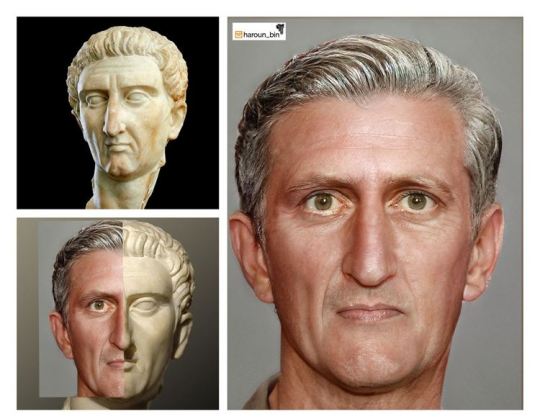
Nerva was chosen just as transitional ruler following the assassination of Emperor Domitian. Except him the successors of "his dynasty" were related.
I'm really sick of hearing things such "Marcus Aurelius broke tradition by choosing moron Commodus just because he was his son; He made a serious mistake".
None of those emperors were chosen after going through a casting. Trajan's adoptive successor was his nephew, the only male relative he had, plus was married to Trajan's great-niece. Hadrian would have been emperor if Trajan had had a son? Marcus Aurelius and his wife Faustina were cousins, both descendants of Trajan, he on his father's side and she on his mother's side. Marcus Aurelius did nothing more than continue the true tradition of his family.
Just as Augustus' dynasty is known as the Julio-Claudian, ending with Nero, Trajan's is the Ulpia-Aelia dynasty, ending with Commodus. And in my opinion the term Nerva Antonine dynasty it just doesn't make sense.
37 notes
·
View notes
Text


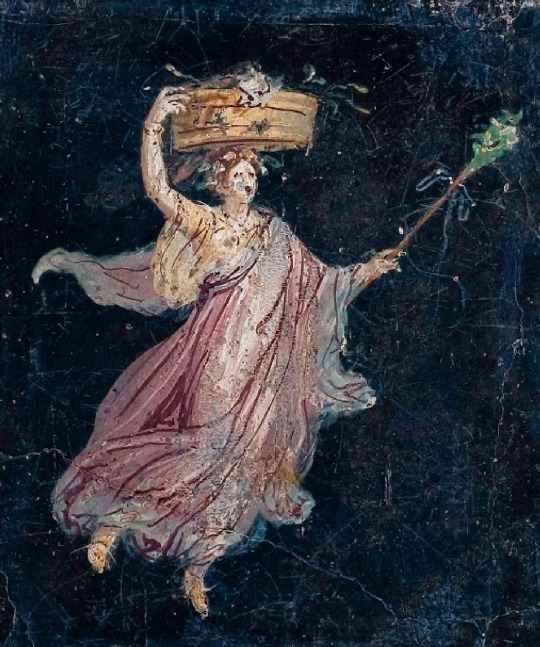

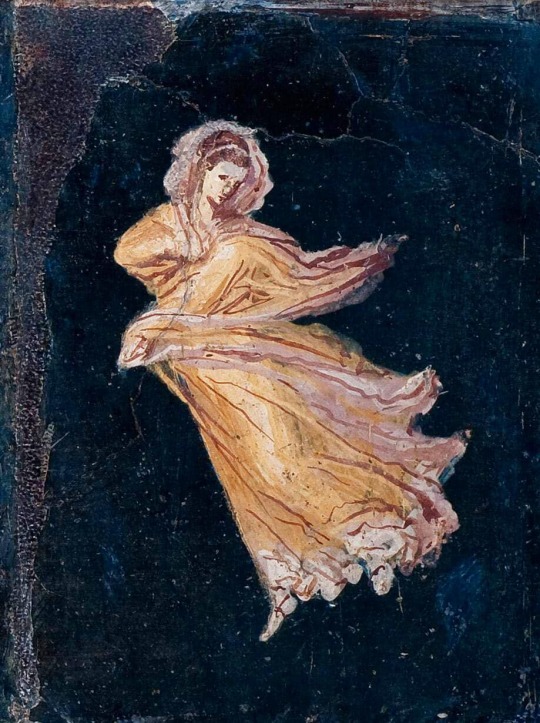
From Villa of Cicero, Pompeii.
118 notes
·
View notes
Text
I love this
350 notes
·
View notes
Text

Head of Oceanus, detail of a mosaic from Baths of Themetra near Sousse, beginning of the 3rd century AD, Sousse Archaeological Museum, Tunisia
By: Carole Raddato (CC)
73 notes
·
View notes
Text

Gladiator- original
69 notes
·
View notes
Photo
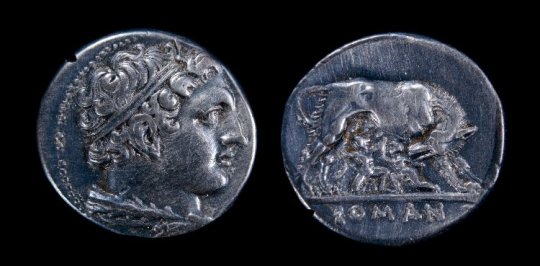
Didrachm with head of Hercules (obverse) and she-wolf suckling Romulus and Remus (reverse)
Roman, Republican Period, 269-266 B.C.
silver
British Museum
599 notes
·
View notes
Text
Commodus: The end of an Era.
"The reign of Commodus marked the end of the Golden Age and the beginning of the Age of Rusty Iron." Cassius Dio (72.36.4)

Lucius Aelius Aurelius Commodus was born on August 31, 161. Curiously, he was born on the same day and month as 'Caligula', the first assassinated Roman emperor. He was the first who been born being the son of the reigning emperor, Marcus Aurelius.
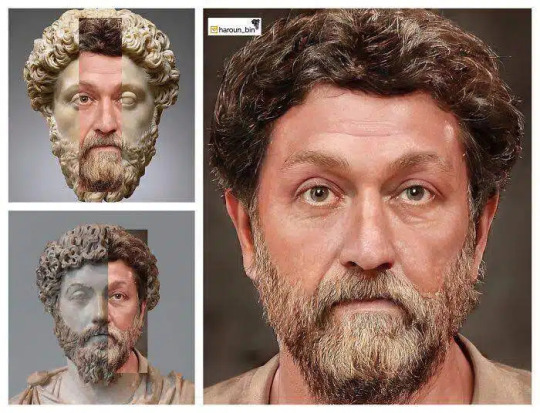

M. Aurelius and Verus ruled together peacefully for eight years. Verus fought against the Parthians who had threatening to take Syria and Armenia. Returned to Rome and had his triumphal parade without knowing that he and his legions were carrying with them a plague that arose in the war zone. The plague spread throughout the empire and was the deadliest in Roman history. In 169 co emperor Lucius Verus died due this plague.
The boy Commodus
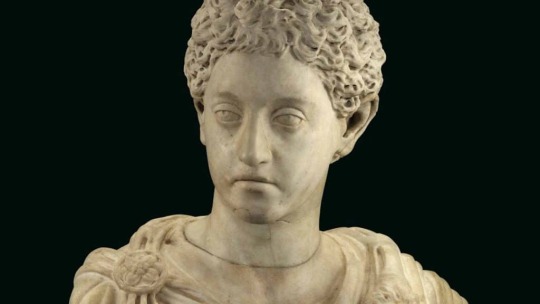
In 172, at age of 11, he received, in the presence of the army in Germania, the title Germanicus (a victory tittle). He participated alongside his father in several battles.
175. Empress Faustina the Younger died of natural causes in Cappadocia where she accompanied her husband. On the same year Commodus entered the College of Pontiffs, which was the starting point of his public career.
176. Marcus Aurelius granted him the position of Imperator, and the following year the title Augustus.
In January of 177, at the age of 15 , he became the youngest consul in the history of the Empire.
178. At age of 16 married to Bruttia Crispina, a very rich 13 year old girl.
March 17, 180, Marcus Aurelius died of natural causes and Commodus became sole emperor at the age of 18.

His first measure was to sign peace treaties both with Germanic tribes and some rebellious people of Britannia. This was frowned upon by his contemporaries, but modern historians agree that it was the only good action he ever took during his entire reign.
About his sister.

Lucilla had been co-empress and held the title Augusta along with her mother when she married the co-emperor Lucius Verus. Following Verus' death, Marcus Aurelius married her to senator Tiberius Pompeianus, a man of humble origins and without ambitions. In this way she lost the privileged position that she had.
In the winter of 181-182 Lucilla with her cousins Quadratus Annianus and Ummidia Faustina, her husband's nephew, Quintianus, and her own daughter Plautia, agreed to assassinate Commodus in the exit hallway of Flavian amphitheater (Colosseum) .The one chosen to kill was Quintianus. Incredibly, although proven, Pompeianus was completely unaware of the plot of his wife.

According to historical sources, when Quintiano saw Commodus, instead of stabbing him, slowly took out his dagger, showed it to him and said "The Senate send to you this dagger." Commodus shouted for his guard who immediately arrested him. The names of the involved were quickly known; Quintianus and Quadrato were executed. Lucilla, her daughter, and U. Faustina were sent into exile on Capri but and also executed there.
Following this event, he distanced himself from the elite and began to trust only in people of humble origins, among them Marcus Aurelius Cleander, former slave and freedman of Marcus Aurelius. In a short time he held important positions until he became the head of the Praetorian Guard.
In 187 due his wife's failure to become pregnant, banished her to Capri. 26-year-old Commodus, instead of marrying another aristocratic woman, chooses to have a concubine- Marcia, daughter of a freedwoman of co-emperor Lucius Verus.

The emperor treated her as a wife, so she had the same power and influence as an empress. It is very probable that Marcia was a Christian since she convinced Commodus to implement a pro-Christian policy, and had a close relationship with Victor I , Bishop of Rome.
Villa of the Quintilii and the rebellion of the people.

Commodus and Marcia retired to the lavish Villa of the Quintilii, whose ruins are today an archaeological site. On April of 190 the people had revolted in Rome because of famine.
There is a suspicion that the shortage of food may have been caused by the prefect of Annona (the import and free distribution of grain to the people) Papirius Dionysius who blamed Cleander.
During a horse-race in the Circus Maximus, the audience to rioted against Cleander. He escaped and managed to reach the Villa of the Quintilii to ask the emperor for help, but the mob followed him there. Commodus, fearing the fury of the people, ordered Cleander to be beheaded.

By then Commodus was already showing signs of an extreme megalomania. The list of people executed, accused without evidence of conspiracy, including his own aunt, consuls, senators and praetorians, is endless. After Lucilla's plot, only one other had been true and proven, the other conspiracies were only in his mind.
He gave himself the title PIUS, like his maternal grandfather emperor Antoninus, and ordered busts of himself to be made representing him as Hercules.
Madness and death.
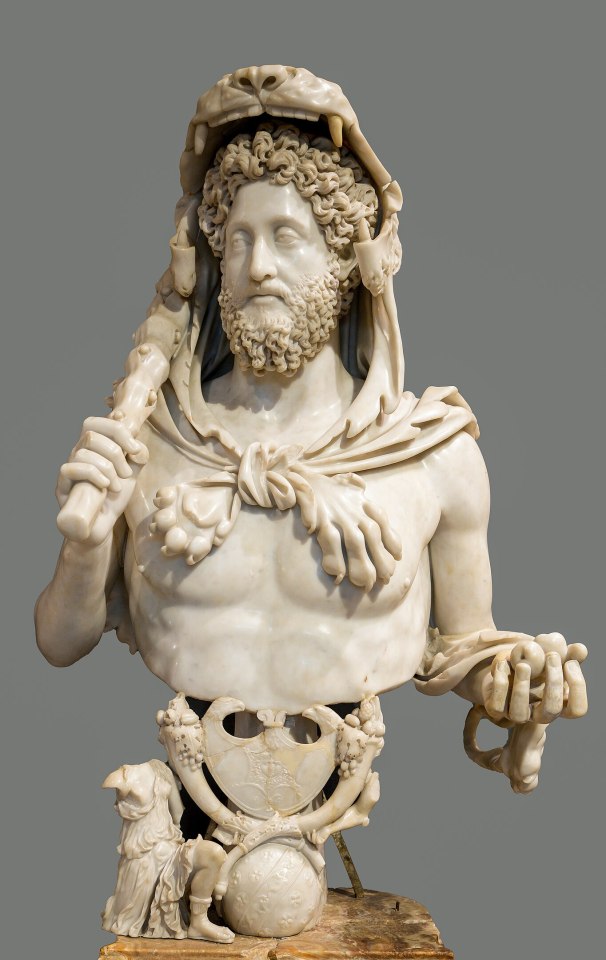

In 192 changed the name of Rome to "Comodiana" and announced that a new era was approaching, he called it Saeculum Felix (Happy Century). The months also was renamed with Commodus own names and titles as well of his dynasty. Thus, the year would begin with the month Imperator followed by Commodus, Augustus, Germanicus, Pius, Lucius, Aelius, Aurelius, etc, not even the mystical July month was saved from this.
According to historical sources, he had shaved his beard, which had been in fashion since his grandfather's time, and also changed his thick curly hair for Gladiator curt hair style. Had his own games in which he competed against gladiators who were forced to consume opium and drink wine excessively.
On December he announced that starting in the new year everything would change in Rome since the Senate wold be dismissed. Senators along with Marcia, who had had enough of Commodus, began to plan his death.
During the feast of December 31 Marcia put poison in his food, but Commodus had drunk too much and vomited immediately, so he ended the party and ordered that his bath be prepared.
Senators made Plan B; They sent a freedman named Narcissus, who "because of his size and strength he did not need to hide daggers or swords, his hands were enough." Narcissus found Commodus in the bathtub, and strangled him. Other sources say he drowned him in the bathtub. Be that as it may, 31 years old Commodus never saw his long-awaited new year.

On January 1, 193, the throne was auctioned to the highest bidder. The final price was stipulated at 25,000 sesterces per soldier. This caused a great scandal in Rome. Pertinax replaced Commodus, but on March he too was killed. Then Didius Julianus ruled for a few days. Finally that year Septimius Severus who was an excellent ruler- after his death, he was deified by the Senate- became the first emperor originally from the province of Africa; Born in Leptis Magna (modern Libya) was of Berber and Punic origin, and with his wife Julia Domna, born in Syria and of Arab origin, they created the Severan Dynasty.
Commodus was not wrong when he said that from that year on everything would change in Rome.

Emperor Septimius Severus ( 193-211 )
42 notes
·
View notes
Text
Beautiful. Thanks for sharing your pictures :)
Personal pictures of some of the BEAUTIFULLY preserved artwork in Pompeii
I took all of these on a study abroad trip that I had the great fortune of being able to go on at the beginning of this year :)
I haven’t been able to STOP thinking about them, so here ya go🤲🏼


i may, or may not, have gotten this one piece of wall art (the pomegranate tree & snake) tattooed on my body…



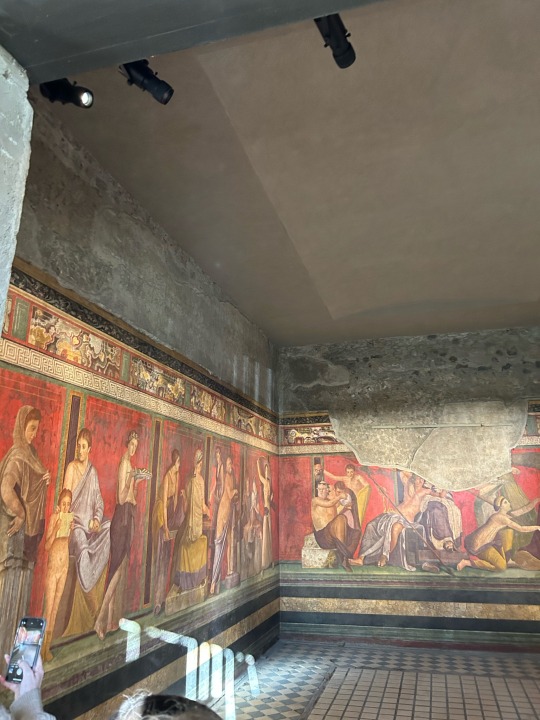
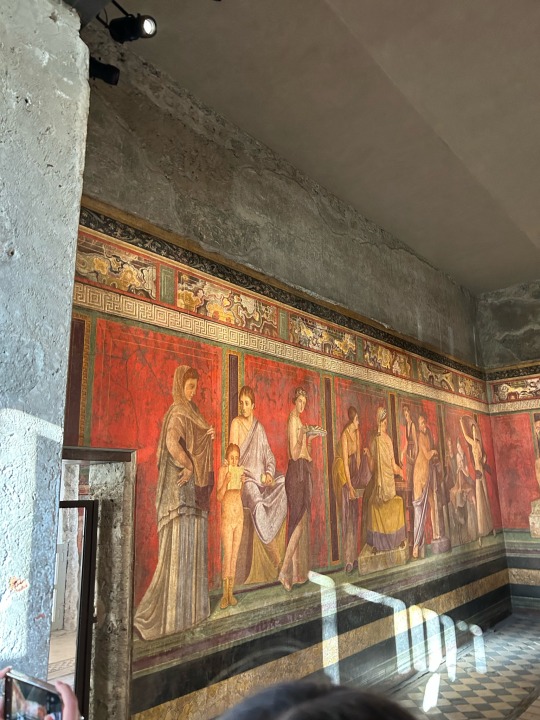
these incredibly detailed wall pieces are a part of the Dionysus Mystery Cult walls and had our whole group stopped for a GOOD 20-30 min…

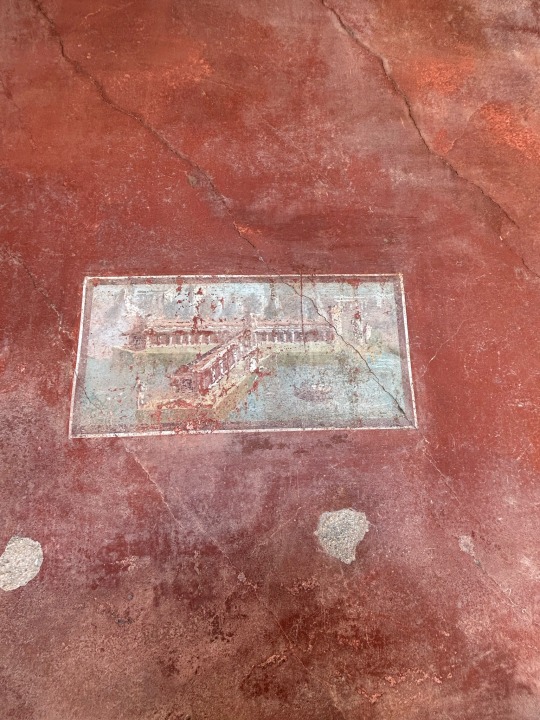

187 notes
·
View notes
Text

Mosaic, III c- Roman Empire, from Tunisia, part of the province that Romans named Africa.
Neptune, the god of the sea, stands in his chariot drawn by two hippocampi. He holds a trident in his right hand, mid-3rd century AD, from Hadrumetum, Sousse Archaeological Museum, Tunisia
Photo: Carole Raddato (cc)
93 notes
·
View notes
Text

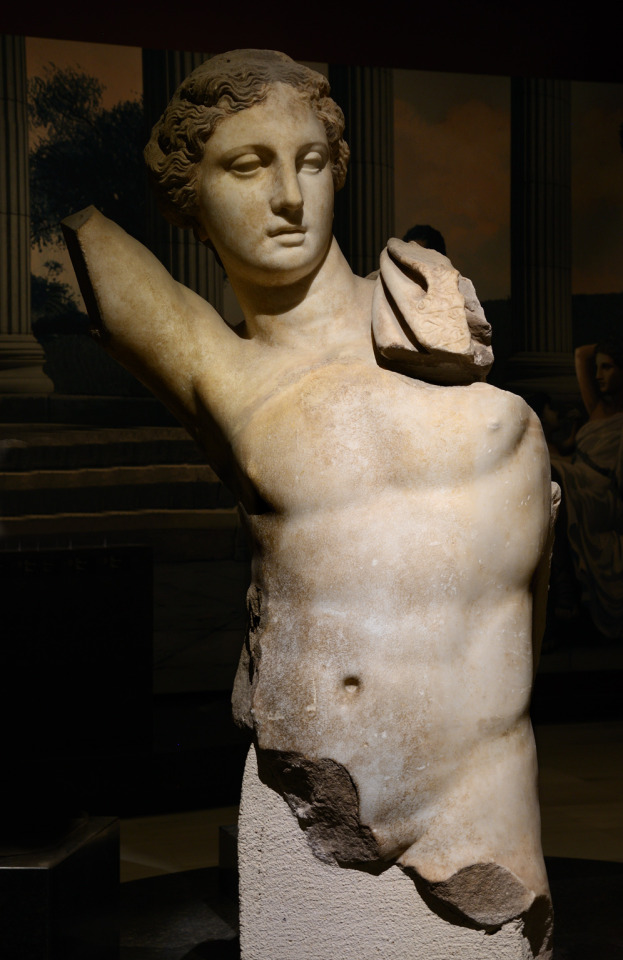


~ Apollo.
Period: Roman
Provinience: Istanbul, Archaeological Museum.
Medium: Marble
904 notes
·
View notes
Text
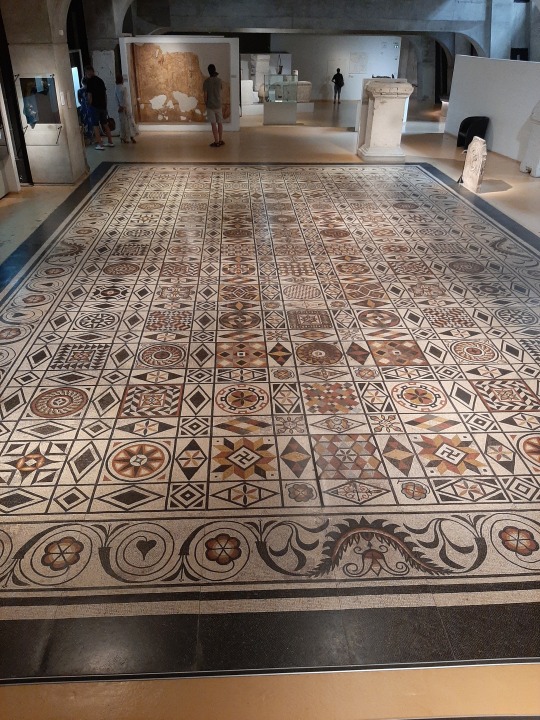

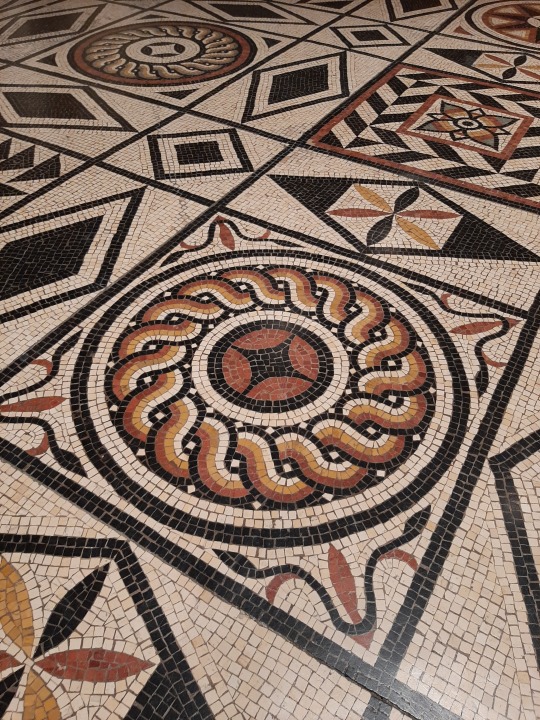
Roman mosaic floor, from the Gallo-Roman Museum of Lyon.
361 notes
·
View notes
Text
The mysterious Pompeii bracelet
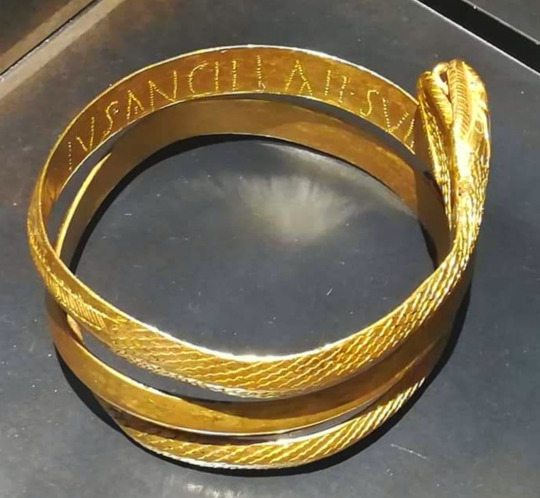
Found in the reamains of a young woman, inside an inn, it is the only specimen in the museum that has an inscription: "DOMINUS ANCILLAE SUAE" which means "From the master to his slave girl."
In a documentary I heard an expert on ancient Rome and Roman jewelry say, "It was unusual for a master to give gifts to his slaves, much less gold gifts, this is a mystery."
139 notes
·
View notes
Text
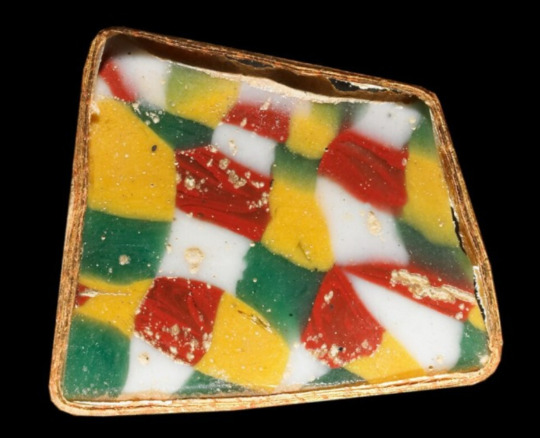


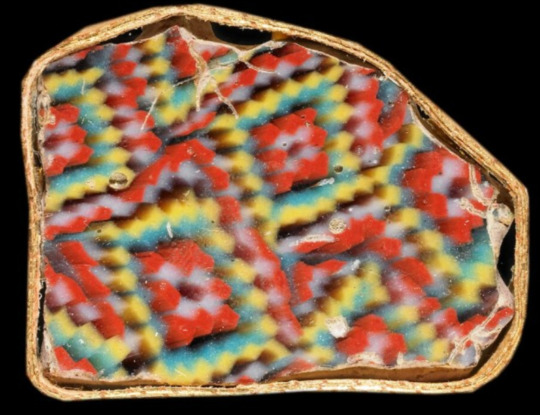
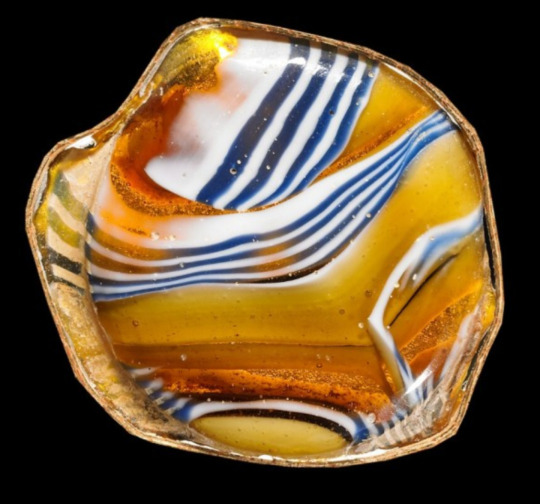
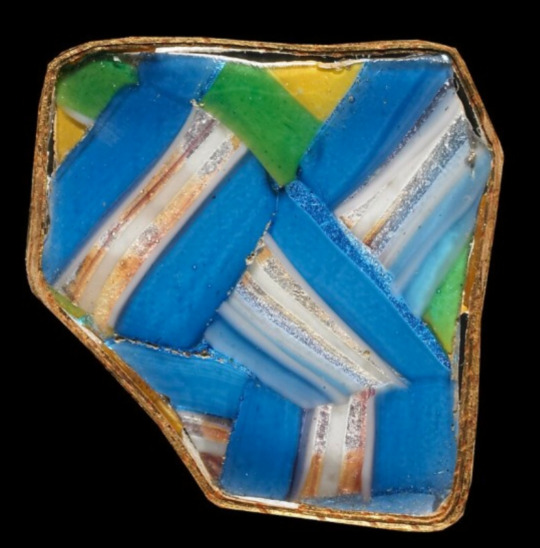
Beautiful colors from Ancient Rome (II)
Mosaic plaque fragments from late Roman Republic time
266 notes
·
View notes
Text
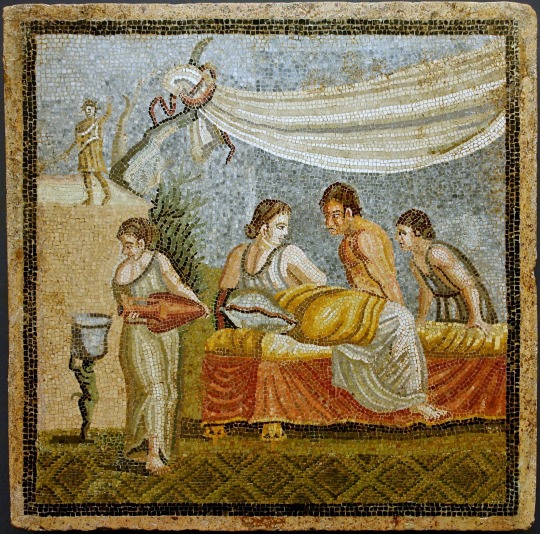
Mosaic known as "Romantic scene", from Centocelle, Rome, 1st c AD
By: Alberto Fernandez /CC BY-SA 2.5 DEED/Wikimedia Commons Kunsthistorisches Museum, Vienna (Austria)
52 notes
·
View notes
Text
April 21st, Rome's Birthday


On this day 2777 years ago ,Romulus became the first king of Rome, founding the city on the Palatine Hill. Beyond legend, archaeological excavations date the first settlements to the same period on the Palatine Hill there were already cabins and a wall.
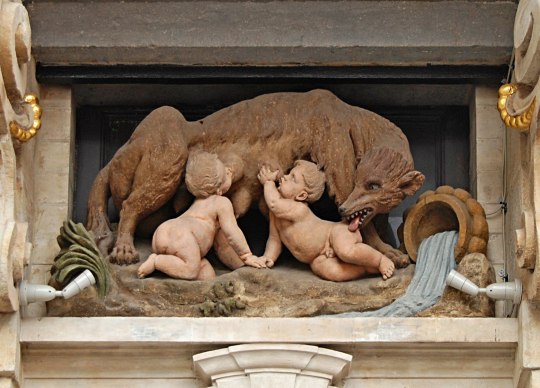
Romulus and Remus in the She-Wolf's House on the Grand-Place in Brussels. Photo by EmDee- CC BY-SA 4.0 DEED-Wikimedia Commons
Like every April 21st, today there is a great celebration in Rome.
173 notes
·
View notes
Text
The mysterious cult of Sabazios
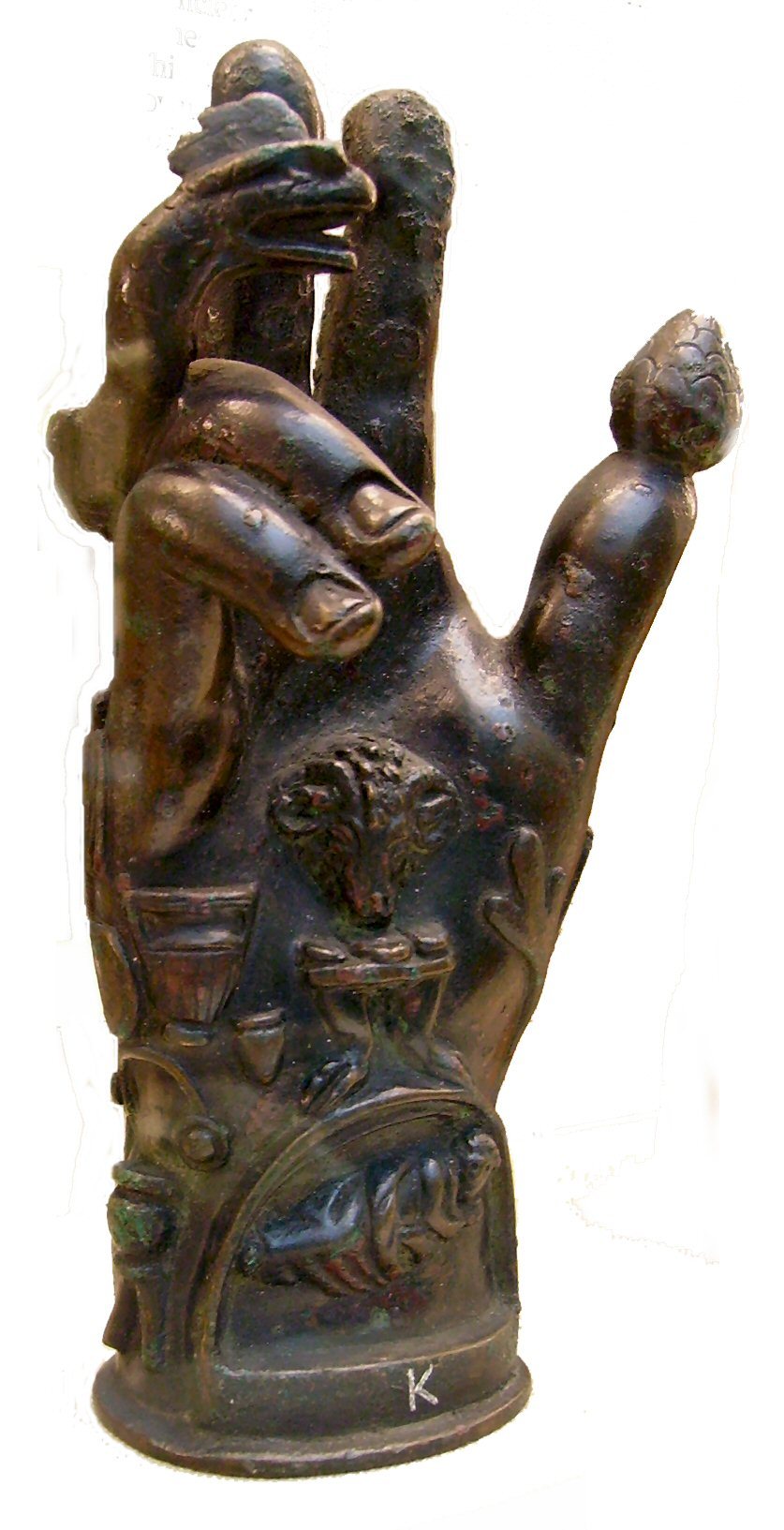
Bronze hand used in the worship of Sabazios. Roman, 1st-2nd century AD (British Museum)
Sabazios, a god of Thracian or Anatolian origin, became popular in the Roman Empire, and had connections both with Jupiter and Dionysos. Hands decorated with religious symbols were designed to stand in sanctuaries or, like this one, were attached to poles for processional use.
By: Mike Young.
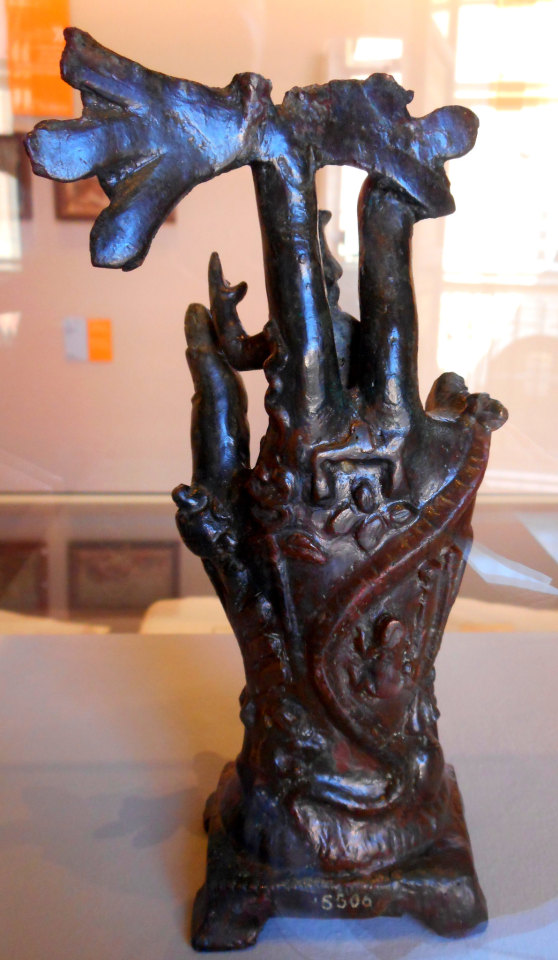
Found in Herculaneum. Photo taken by Carlo Raso at the Exhibition "Herculaneum and Pompeii: Vision of Discovery". Archaeological Museum of Naples.
References to the cult of Sabazios are found in the comedies of Aristophanes, which emphasize the non-Greek character of the god and the use of rituals full of emotion and accompanied by lively music and trance states. The cult of Sabazios was orgiastic; According to Diodorus, the rites were carried out at night and the initiation ceremonies consisted of several rites.
Strabo's Sicilian contemporary Diodorus Siculus (1st century BC) mixed Sabazios with the secret "second" Dionysus, born of Zeus and Persephone.

From the Roman period (1st century AD) found on the Island of Escombreras (Cartagena, Spain) and preserved in the National Museum of Underwater Archeology. By: Nano Sanchez.
According to modern scholars, not a single temple dedicated to Sabazios has been located in Roman sites, although an inscription built on the wall of the abbey church of San Venanzio in Ceparana, Italy, suggested to a Renaissance humanist, that it had been built on the foundations of a temple to Jupiter Sabacio. The symbolism of these objects is not well known.
Texts from Wikipedia
46 notes
·
View notes
Text

"Selene and Endymion" - wall painting (1st century AD) from Herculaneum. National Archaeological Museum of Naples, Italy
Photo courtesy of Carlo Raso
The divine Selene sees the beautiful Endymion sleeping. She falls in love with him to her perdition and obtains eternal youth and perpetual sleep from Zeus for him, which allows her to often come and contemplate her perfect features. All with the complicity of Cupid.
Text : Carlo Raso
41 notes
·
View notes